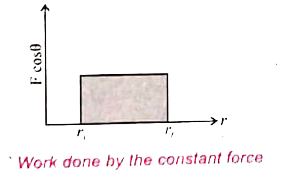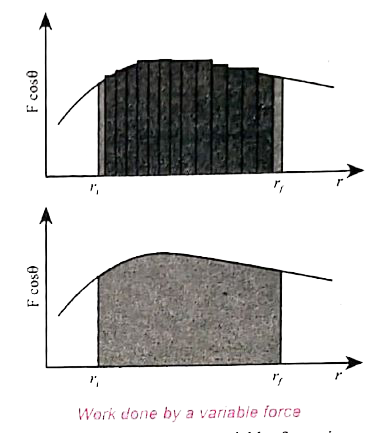Explain with graphs the difference between work done by a constant force and by a variable force. Solution in Tamil
Video Solution
Text Solution
When a constant force F acts on a body, the small work done (dW) by the force in producing a small displacement dr is given by,
dW=(Fcosθ)dr
The total work done in producing a displacement from initial position ri to final position rf is, given by
W=rf∫ridW
W=rf∫ri(Fcosθ)dr
=(Fcosθ)rf∫ridr
=(Fcosθ)(rf−ri)

the graphical representation of the work done by a constant force is as shown in the figure. The work done by the constant force is given by the area under the graph.
Work done by a variable force: When the component of a variable force F acts on a body, the small amount of work done (dW) by the force in producing a small displacement dr is given by the relation,
dW=(Fcosθ)dr
where, F and θ are variables. The total work done by a body for a displacement from initial position ri to final position rf is given by the relation
W=rf∫ridW=rf∫riFcosθdr

The work done by a variable force is as represented by a graph as shown in figure. The area under the graph is the work done by the variable force.
|
Similar Questions
Explain with graphs the difference between work done by a constant force and by a variable force.
View SolutionWork done by a constant force and Work done by a variable force
View SolutionWork done by a constant force and Work done by a variable force
View SolutionExplain work done by a constant force .
View SolutionWork Done by Variable Force
View SolutionWork Done By Constant and Variable Forces
View SolutionExplain work done by a variable force.
View SolutionExplain the work done by the constant force and the variable force.
View Solution
